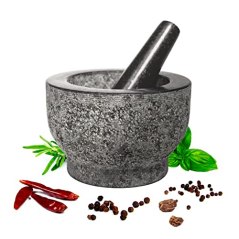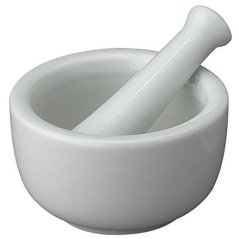
Solidly crafted in natural granite, this model looks great and is made to last. Season it, rinse, and enjoy.
Solidly crafted in natural granite, this model looks great and is made to last. Season it, rinse, and enjoy.
Garners enthusiasm for a rugged build that provides excellent leverage for mashing and grinding numerous ingredients. Made of granite that is easy to clean. Pieces can be placed in the dishwasher. Versatile size.
Heavy, but also durable. Requires seasoning to smooth out rough areas, but works well once this task is performed.

An inexpensive set made of porcelain that's perfect for the budding chef.
An inexpensive set made of porcelain that's perfect for the budding chef.
High sides prevent ingredients being ground inside from falling over the sides. Smaller size makes it easy to store. Can be run through the dishwasher for cleanup.
It's porcelain, so it's a little delicate, according to some reviewers.

A super-durable stainless steel option for the clumsy cook.
A super-durable stainless steel option for the clumsy cook.
Stainless steel components are easy to clean. Set grinds down ingredients effectively. Heavy enough that it won't move around while you mash. Looks good on display in a modern kitchen.
A small percentage of users complained of units arriving with small rust stains.

Silicone edges for a no-slip ingredient prep experience.
Silicone edges for a no-slip ingredient prep experience.
Silicone grip makes pestle easy to hold. Both parts can go in the dishwasher. Bottom of bowl features a silicone ring so it stays put when in use. Crushes just as well as a traditional set.
Heavier than some users expected and a little tough to fit inside the dishwasher.

Granite set offers classic looks for a decent price. Mortar easily doubles as a serving bowl, but be careful not to scratch your table.
Granite set offers classic looks for a decent price. Mortar easily doubles as a serving bowl, but be careful not to scratch your table.
Offers a reasonable price for a solid granite set in a versatile size. Design makes it easy to thoroughly grind ingredients. Doesn't require extensive prep before use. Easy to clean.
Feels weighty, but this is a testament to its durability. Leg bottoms are rough and can scratch surfaces.

We recommend these products based on an intensive research process that's designed to cut through the noise and find the top products in this space. Guided by experts, we spend hours looking into the factors that matter, to bring you these selections.

The mortar and pestle is a simple tool that has been used since ancient times to crush, grind, and pulverize a wide variety of items, including food and medicine. When it comes to changing the consistency of numerous types of substances, this handy tool and bowl duo is just as relevant today as it was tens of thousands of years ago.
Grains, spices, seeds, pills, and more can be placed in a mortar and mashed with the pestle. These tools are made of materials like ceramic, metal, and stone, and are constructed to hold up to the wear and tear of repetitive grinding motions. Though mortars and pestles that are large enough to be placed on the ground and operated with two hands are still used in some countries, most consumer models fit in one hand and can be used on a table or countertop.
The mortar and pestle isn’t a complicated tool, but you still want to make sure that the pair you choose will fit your needs and is built to last.

Just like the name implies, a mortar and pestle consists of two pieces. The mortar is shaped like a bowl and designed to keep contents contained while being pulverized and mixed. The pestle is cylindrical in shape, with a rounded top and a sturdy build to increase leverage. All you have to do is place the substance you want to grind in the mortar, grip the pestle firmly, and go to work. You can control the resulting consistency by how rigorously you maneuver the pestle — a lighter touch with less force results in coarsely ground materials, while more rigorous motions can turn ingredients into powders or pastes.
While today’s cooks have many electric-powered options for chopping and grinding ingredients, there are still people who enjoy preparing foods like herbs, spices, and vegetables by hand with a mortar and pestle. You can even use it for altering medications, just like yesterday’s medicine men did. Here are some ideas for putting your mortar and pestle to good use:
Stone: Granite, marble, and agate are the most popular types of stones used to make mortars and pestles. Granite typically has a rougher finish, making it more suitable for grinding small pieces that may slide around on the slick surfaces of marble and granite.
Metal: Although some models are made of base metals, stainless steel is the most popular because of its durability and resistance to wear, tear, and corrosion. Cast iron mortars and pestles aren’t as common, but they are designed for heavy-duty use.
Wood: Wood mortars and pestles aren’t quite as durable as other options. They’re the most porous and can absorb oils, odors, and flavors. However, wood earns praise for being natural, easy to use, and less heavy to handle than other materials.
Ceramic: This material is also somewhat porous, and is best for small tasks like grinding pills and seeds.
Porcelain: More durable and less porous than ceramic, porcelain’s smooth surface makes it easy to clean. It can be difficult to smash small, slippery items with a porcelain mortar and pestle, but it’s a great tool for preparing moist or oily ingredients.
Some models also feature plastic or silicone-coated bases and handles that improve traction and grip.
Mortars and pestles are available in different sizes to accommodate different needs. Smaller models with mortars that are about 2.5 to 3 inches are best for small tasks, like grinding pills, herbs, spices, nuts, and seeds. Larger options range from around 3.5 to 8 inches and are best for preparing sauce, paste, salsa, guacamole, and similar dishes. Keep in mind that these measurements represent the diameter of the mortars, but the matching pestles are similarly sized in length for a workable balance. Mortar depth varies, but it typically ranges from 1.5 inches to 6 inches in height.
Most mortars and pestles have a solid, hefty feel because the work that they’re built to withstand requires pressure and friction.
The base is designed to prevent the mortar from slipping while substances are being ground with the pestle. Broader bases are best suited for tasks that require more rigorous mashing, like nuts and grains. Some mortars have more narrow, foot-like bases or individual legs, and are best for working with softer ingredients.
Inexpensive: Mortars and pestles in this category fall on the price spectrum from $6 to $12. Smaller models, and those made of less pricey materials like wood and ceramic, can be found in this range.
Mid-range: Expect to pay about $15 to $20 for medium to large mortars and pestles made of ceramic and metal. Some models made of higher-quality marble and wood are also available at this price point, as well as some lesser-quality granite options.
Expensive: If you want a large mortar and pestle, or one made of top-quality granite, you’ll pay around $25 to $50 or a bit more.


Q. Can I clean a mortar and pestle in the dishwasher?
A. The answer is actually yes and no because it depends on the material. Wood, ceramic, and stainless steel models are usually dishwasher-safe, while those made of different types of rock and wood should be washed by hand. It’s also best to avoid the dishwasher if you have a mortar and pestle with silicone-coated handles and bases.
Q. What materials are best for a mortar and pestle that will primarily be used for preparing moist ingredients?
A. Metal and porcelain mortars and pestles are best suited for mashing and mixing soft, wet ingredients because they aren’t porous. Materials like wood, ceramic, and some types of porous rock may trap moisture and retain odors and flavors from wet substances; plus they are more difficult to clean.
Q. Why do some mortars and pestles need to be “seasoned”, and how do you season them?
A. Some mortars and pestles that are made of natural rock can have a rough surface from which small pieces can flake off into food. Seasoning prevents this from happening by smoothing out the rough edges, plus it’s easy to do. After rinsing off your new mortar and pestle, rigorously crush dry rice into it. Rinse and repeat as needed until the inside of the mortar surface develops a grit-free feel.
Get emails you’ll love.
Learn about the products you’re wondering if you should buy and get advice on using your latest purchases.
